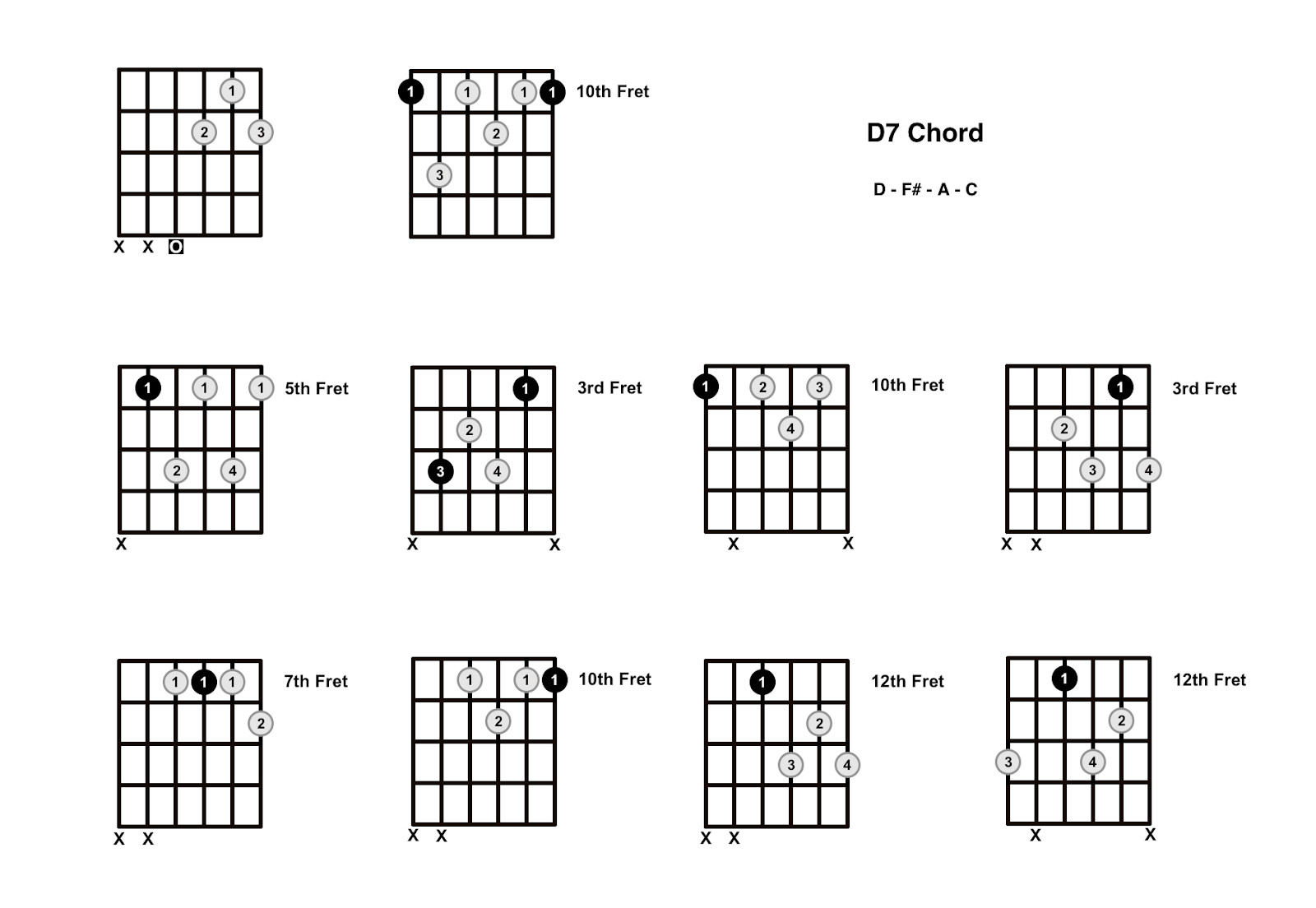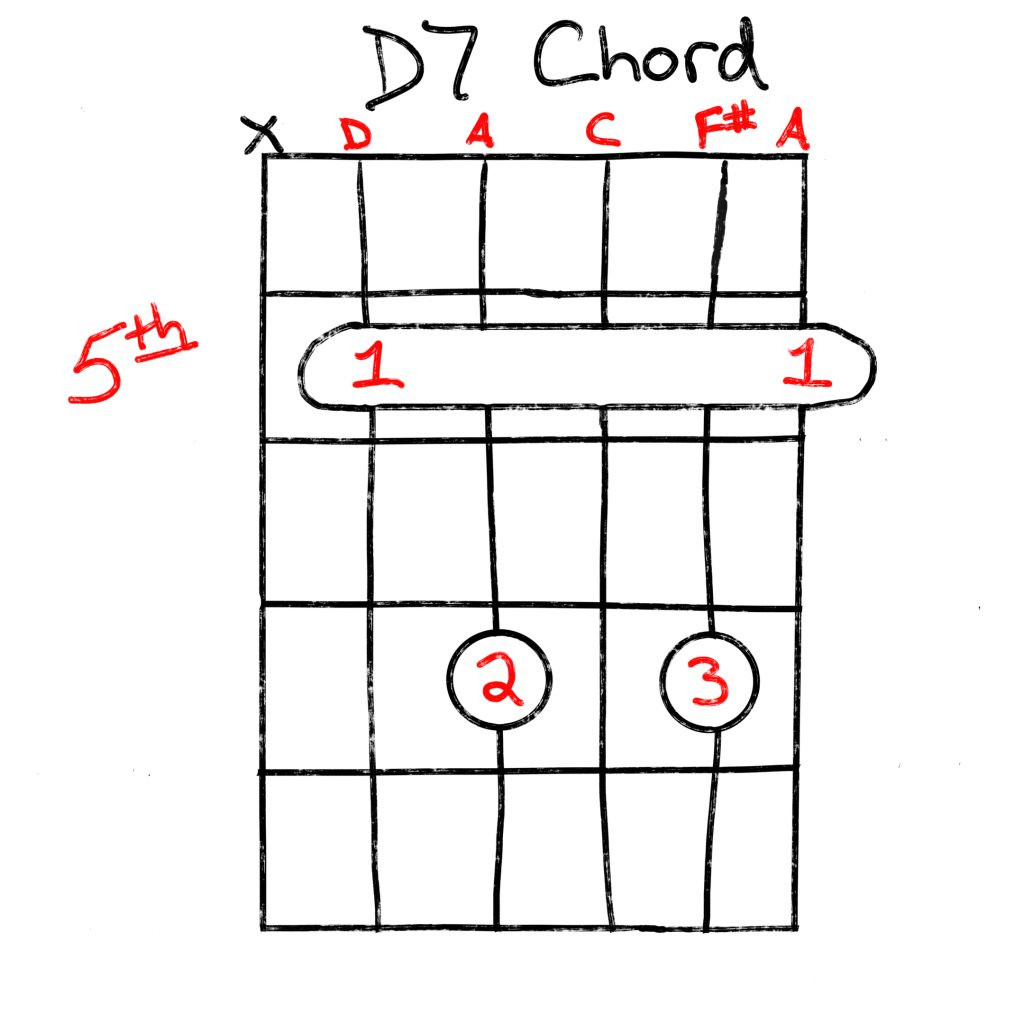Embarking on your guitar journey involves learning a variety of chords, and the D7 guitar chord is a vital one to add to your repertoire. Often referred to as the D dominant seventh chord, the D7 brings a unique, uplifting quality to your playing, frequently heard across genres from country to mellow rock. Its versatility extends further, making appearances in jazz, classical music, and even pop tunes. Whether you’re just starting out or looking to expand your chord vocabulary, understanding and playing the D7 On The Guitar is an essential step.
If you’ve encountered the D7 chord and felt unsure about how to play it, or perhaps you’re completely new to this chord, you’ve landed in the right place. This guide will provide you with a comprehensive understanding of the D7 guitar chord, covering everything from its basic construction to various ways to play it and its application in popular music. Let’s dive into the world of the D7 chord and unlock its potential in your guitar playing.
Understanding the D7 Chord: Building Blocks and Theory
The D7 chord is a four-note chord, constructed from the D major scale with an added flattened seventh. Specifically, the notes that make up the D7 chord are D (the root), F# (major third), A (perfect fifth), and C (minor seventh or flat seventh). This combination of notes creates a dominant seventh sound, which is characterized by its slightly dissonant yet pleasing tension that often resolves to a tonic chord – typically a G chord in the key of D.
This dominant seventh quality is what gives the D7 chord its distinctive character. It’s richer and more complex than a simple D major chord, adding depth and color to chord progressions. Understanding this basic theory helps appreciate why the D7 chord is so widely used across different musical styles.
How to Play the Open D7 Chord on Guitar
The most common and often easiest way to play the D7 on the guitar is in its open position. This voicing is fundamental and a great starting point for beginners. Here’s a step-by-step guide to playing the open D7 chord:
Finger Placement:
- Index Finger (1st Finger): Place your index finger on the 2nd fret of the G string (3rd string from the thickest).
- Middle Finger (2nd Finger): Place your middle finger on the 2nd fret of the high E string (1st string).
- Ring Finger (3rd Finger): Place your ring finger on the 3rd fret of the B string (2nd string).
 D7 chord diagram for guitar, showing finger positions on the fretboard for the open D dominant 7th chord.
D7 chord diagram for guitar, showing finger positions on the fretboard for the open D dominant 7th chord.
Strumming:
Once your fingers are correctly positioned, ensure you only strum the top four strings – D, G, B, and high E. Avoid strumming the Low E string (thickest string) as it’s not part of the open D7 chord voicing. This is a common mistake for beginners, so pay close attention to your strumming hand.
Tips for Beginners:
- Finger Curvature: Ensure your fingers are curved so that you are pressing down only on the intended strings and not muting adjacent strings.
- Pressure: Apply enough pressure just behind the fret to get a clear sound without buzzing. Don’t press too hard, as this can cause strain.
- Strumming Technique: Start with slow, controlled strums to ensure you are hitting the correct strings and each note rings out clearly.
Exploring Different D7 Chord Voicings
While the open D7 chord is the most common starting point, there are other ways to play the D7 on the guitar, offering different tonal colors and voicings. Here are a few variations:
D7 Chord with Open A String
This variation is essentially the same as the open D7 chord described above, but it clarifies that you are using the open A string as the root in the bass. The finger positions remain identical:
- Index Finger: 2nd fret of the G string.
- Middle Finger: 2nd fret of the high E string.
- Ring Finger: 3rd fret of the B string.
Strum from the A string downwards, avoiding the Low E string.
D7 Chord with Open G String
This is likely a slight misnomer or variation not commonly referred to as a distinct “voicing” but rather just the standard open D7. The finger placement described in the original article as “D7 Chord With Open G String” is actually the same finger placement as the “Open D7 Chord”. It is the standard open D7 voicing.
Barre D7 Chord
For a different sound and to play the D7 chord in other positions on the neck, you can use a barre chord. The barre D7 chord shape is movable, allowing you to play D7 and other dominant 7th chords up and down the fretboard. Here’s how to play a barre D7 chord starting at the 2nd fret:
Finger Placement:
- Index Finger (1st Finger): Barre your index finger across all six strings at the 2nd fret.
- Middle Finger (2nd Finger): Place your middle finger on the 3rd fret of the B string.
- Ring Finger (3rd Finger): Place your ring finger on the 4th fret of the D string.
- Pinky Finger (4th Finger): Place your pinky finger on the 5th fret of the A string.
 Barre D7 chord diagram on guitar, illustrating finger placement for the D dominant 7th barre chord at the 2nd fret.
Barre D7 chord diagram on guitar, illustrating finger placement for the D dominant 7th barre chord at the 2nd fret.
Strumming:
Strum all six strings for this barre chord voicing.
Moving the Barre D7 Chord:
You can move this barre chord shape up the neck to play other dominant 7th chords. For example, move it up two frets (barre at the 4th fret) to play an E7 chord, and so on.
The D7 Chord in Different Music Genres
The D7 chord’s versatility makes it a staple in various music genres:
- Blues: D7 is incredibly common in blues music, often used as the I chord in a 12-bar blues progression in the key of D.
- Country: As mentioned, D7 adds that uplifting, slightly jazzy feel to country music. It’s frequently used in country chord progressions.
- Rock and Roll/Mellow Rock: From classic rock and roll to softer rock styles, D7 provides a richer harmonic texture compared to just major chords.
- Jazz: Dominant 7th chords are fundamental to jazz harmony. D7 is used extensively in jazz progressions and improvisations.
- Pop: While perhaps less prominent than in genres like jazz or blues, D7 can still be found in pop music to add harmonic interest and transitions.
- Classical Music: Dominant 7th chords, including D7, have been a part of classical harmony for centuries, used to create tension and resolution.
Popular Songs Featuring the D7 Guitar Chord
Learning songs is a fantastic way to solidify your understanding and playing of chords. Here are a few well-known songs that prominently feature the D7 chord:
-
“Can’t Help Falling in Love” – Elvis Presley: This timeless classic utilizes the D7 chord in its chorus progression, contributing to its gentle and romantic melody.
-
“Ain’t No Sunshine” – Bill Withers: This soulful hit is instantly recognizable for its repeating chord progression, which heavily features the D7 chord. Practicing this song is excellent for getting comfortable with D7 transitions.
-
“Brown Eyed Girl” – Van Morrison: This upbeat and cheerful song makes significant use of the D7 chord throughout, making it another great song to learn when mastering the D7.
-
“Hey Good Lookin'” – Hank Williams: A country classic that uses D7 prominently in its upbeat and catchy progression.
-
“Kansas City” – Wilbert Harrison (and famously covered by The Beatles): This rock and roll standard frequently uses the D7 chord, contributing to its energetic rhythm.
Tips for Mastering the D7 Chord
- Practice Regularly: Consistent practice is key. Spend a few minutes each day practicing the D7 chord and transitioning to and from other chords you know.
- Chord Transitions: Practice smoothly transitioning between D7 and other common chords like G, D, A, and Em. This will help you use D7 in actual songs.
- Listen Carefully: Pay attention to the sound of the D7 chord. Ensure each note rings clearly and that you are strumming the correct strings for each voicing.
- Experiment with Strumming Patterns: Once you can play the D7 chord cleanly, try different strumming patterns to add rhythm and dynamics to your playing.
- Learn Songs: As mentioned, learning songs that use the D7 chord is a fun and effective way to improve your skills and musicality.
- Don’t Get Discouraged: Learning guitar takes time and patience. If you find the D7 chord challenging at first, keep practicing, and you will eventually master it.
Conclusion
The D7 guitar chord is an invaluable addition to any guitarist’s toolkit. Its rich sound and versatility make it applicable across a wide range of musical styles and songs. By understanding its construction, practicing different voicings, and learning songs that feature it, you’ll not only master the D7 on the guitar but also expand your musical horizons. So, pick up your guitar, practice the D7 chord, and start incorporating this essential chord into your playing today!
